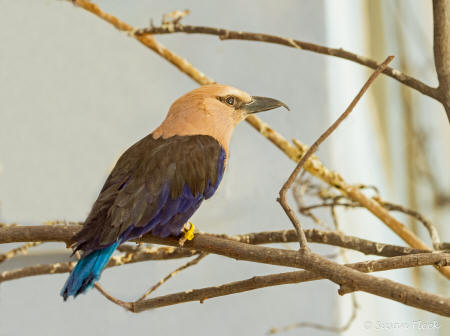
|
(sources: Wikipedia & Toronto Zoo websites) The Blue-bellied
Roller (Coracias cyanogaster) is a member of the
roller family of
birds which breeds across
Africa in a narrow rainforest belt
from
Senegal to northeast
Democratic Republic of the Congo.
It is resident, apart from some local seasonal movements, in mature
moist savannah dominated by
Isoberlinia trees. This is a
common bird of warm open country with some trees. These rollers
often perch prominently on trees, posts, or overhead wires, like
giant
shrikes, whilst watching for the
grasshoppers and other large
insects on which they feed. The
display of this bird is a
lapwing-like display, with the
twists and turns that give this species its English name. It nests
in a hole in a tree - a tree cavity.
Perched, it resembles a crow with its stocky build and large beak.
In fact, the Latin word coracium means "like a raven".
|

|
The blue-bellied roller is a carnivore that feeds on just about any
invertebrate it finds on the ground. In one Côte d’Ivoire survey of
their stomach contents, their preferences were found to be: 30%
grasshoppers, 28% beetles and 16% termites and ants. Other snacks
they like are wasps, mantises, antlion larvae (known as doodlebugs
in North America), millipedes, and earthworms. They will even eat
noxious insects with indicative coloration. Occasionally they will
catch a small skink or snake. Unlike other rollers, this one will
eat some vegetation, specifically the palm-oil nut.
Fast chases indicate that courtship has begun. The chasing bird will
break away and speed downwards, tumbling, calling raucously, and
rolling its body from side to side. This is why the family is called
rollers.
The nest is built about ten metres up a small tree or in a palm-tree
cavity. Two to three eggs will be laid, though at higher latitudes
it could be up to six. Both parents incubate for about three weeks
though the female sits the most. Born altricial, the hatchlings take
four weeks to fledge. During this time, juveniles from previous
broods will assist with feeding. Food is regurgitated. |
Blue-bellied rollers also keep an eye out for intruders into their
territory. While on patrol, they display their brilliant plumage. If
that doesn’t stop an intruder, they will make rolling dives while
calling shrilly to scare others away. During nesting, they are
particularly aggressive. They show no fear no matter the size of a
potential predator. Blue-bellied rollers will stay together most of
the day in groups of two, three or four, spending most of their time
feeding and calling. They often roost in larger groups of up to
twelve. However, by nature, they are irritable and aggressive. These
traits evolved before the spread of agriculture when clearings would
have been fewer, meaning competition for hunting trees would have
been greater. They had to have ways to express hostility without
resorting to fighting, which might be devastating with their
powerful beaks.
A complex system of postures and movements to communicate social
information developed. For example, ruffling of the neck feathers
often precedes an advance on the other bird. Staring often induces
the other bird to retreat. Pecking the ground may be redirected
attack. An erect posture with the crown high and the bill pointing
groundward shows extreme aggression. Pseudosexual and reverse
copulation threatens other birds in the area as well as being an
outlet for aggression. These behaviors and others evolved to prevent
bloodshed amongst blue-bellied rollers.
|
|